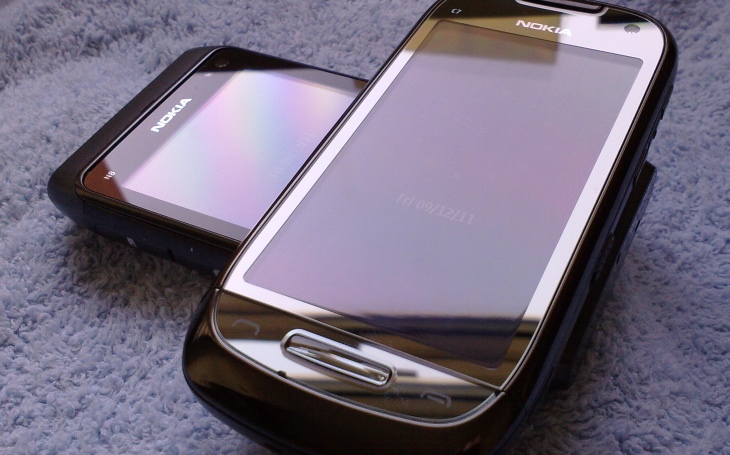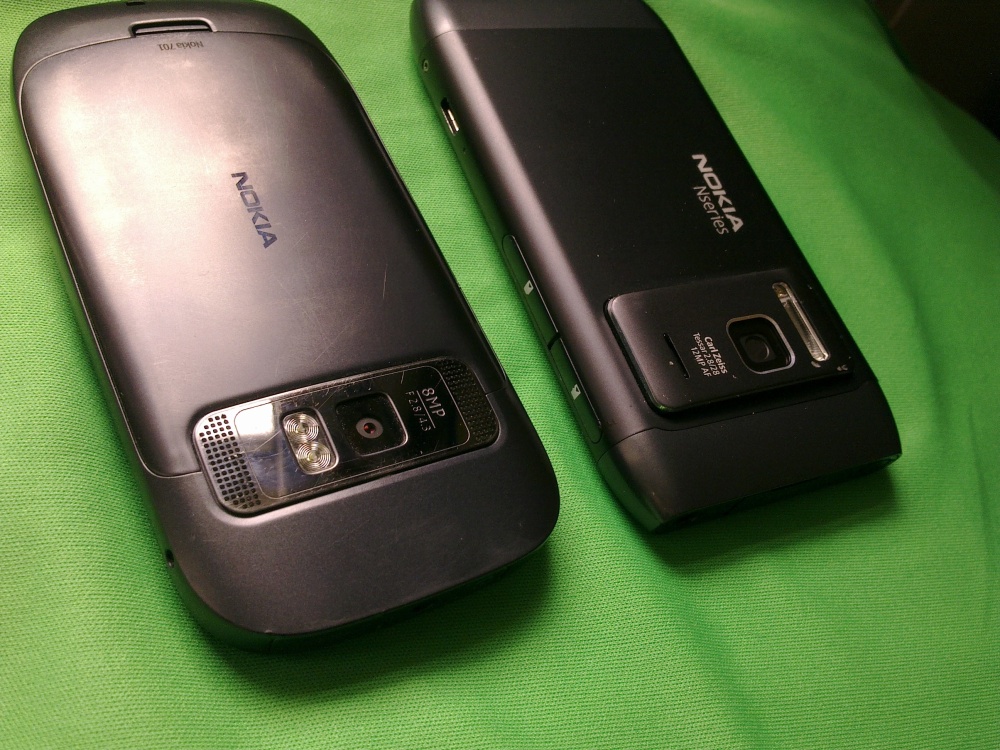As far as the tech press is concerned, Symbian is dead and buried, going into 2013. They wrote the OS off in 2009 and were wrong, then again in 2010 and were wrong, with the N8 generation coming out of the gate strongly. Then with Nokia itself seemingly cutting off it own OS in February 2011, the press had a field day and things have rather gone downhill in terms of media appreciation and sales ever since. But let's not rehash the Symbian/Meego/Windows Phone debate all over again.
Instead, acknowledging that many people (including me) still rather like Symbian and love how it can be turned, customised, added to and tweaked to near perfection, let's take an honest look at the devices available at how they stack up as the New Year approaches.
Where do I draw the line? Pre-Symbian^3 is out, I think. I've got a load of S60 3rd Edition phones, notably the E90, E72, N86 and N82, which I'm rather fond of and which I get out to update and play with from time to time. Ditto my old Nokia X6 and even N97 mini, each flawed by virtue of the clunkiness of Nokia's attempted conversion of S60 to be touch-friendly. And while the core of what most of us do with our smartphones can be achieved with any of these, the screens and processors don't really compete - one look at the competition (say, a Galaxy S III, lightning fast and with enormous 4.8" display) and it's clear that things have moved on.
Between 2004 and 2008, Nokia introduced numerous convergence innovations (most notably GPS, Wi-fi and decent cameras), but there has been a new phase of hardware development in the last couple of years, centred around content consumption. We're now rolling media players/TVs, games consoles and desktop class web browsing experiences into the typical smartphone definition. Thankfully for Nokia, it still produces devices with, on the whole, better quality components than much of the competition, which is why there's still a place for some of the current Symbian handsets, albeit with a few caveats here and there. Read on...
Looking then at everything from the Nokia N8 onwards (so September 2010 to the present day), here's the Symbian-powered device roster (those which are still fit for purpose in 2013 have their notes shaded in turquoise):
| Nokia Device |
Introduced | Notes for 2013 |
| N8 | Sept 2010 | Still very useable, thanks to Nokia Belle Refresh and the still insanely great camera, speaker and build quality. Main limitations are screen size (3.5") and clarity (no CBD). |
| C7 | Sept 2010 | Still useable, the curvy design still looks fresh, plus the dual charging, FM transmitter, replaceable battery all still rock, though the EDoF camera isn't everyone's cup of tea. Again, Belle Refresh works well. The screen's again a little small, but may suit typical C7 owners, I suspect. |
| C6-01 | Sept 2010 | Although a decent small handset, a 3.2" display doesn't really work with most 2013 expectations. Text input is fiddly too. Rule this one out. |
| E7 | Sept 2010 | Ah yes, the most flawed Nokia business phone ever? Crippled by its own design contraints (sealed battery, sealed memory, EDoF camera) and with firmware that's still buggy to this day, we can rule the E7 out immediately, despite the lovely keyboard and screen. |
| X7 | April 2011 | The design from hell. Part Star Trek, part NASA and all compromise. Nothing worked well, everything was sealed or compromised. Disappointing all round. |
| E6 | April 2011 | The best of the Candybar QWERTY designs in terms of specs, but despite great build quality, the E6 was always a bit of a kludge. Sometimes the interface worked, sometimes it didn't, sometimes fonts were too large, sometimes too small, sometimes elements weren't on the screen at all. Great hardware, but again a compromise too far and I don't think anyone could seriously countenance a 2.4" screen in 2013, whatever the form factor. |
| 500 | Aug 2011 | A curious strike for the ultra-budget end of the market, the 500's an odd one out, ultimately limited in specs, in terms of rendering power, games and other software. Best avoided. |
| 701 | Aug 2011 | The sister device of the C7, updated a year on with twice the processor power and RAM and with updated OS architecture, plus EDoF v2 camera. Still looks a million dollars and a great performer, though the CBD TFT screen doesn't quite have so much 'wow' as the C7's. |
| 700 | Aug 2011 | Another 'year on' update, this time to the C6-01, producing the stylish 700 with faster everything and gorgeous AMOLED screen - but too small. This could still have been a sleeper hit but Nokia compromised too far on components, mainly speaker and camera. |
| 603 | Oct 2011 | No idea. Have never seen this in the wild in the UK, so I'll rule it out on those grounds alone. |
| 808 | Feb 2012 | Still the Symbian flagship in almost every regard. Specifications are off the scale, relatively speaking, in the Symbian world. Led by the monster 41-megapixel sensored camera, Nokia essentially stuck every hardware gadget they could find, from all previous devices, all in the one device. And it doesn't look too bad. Now running Belle Feature Pack 2, as does the 701 above. Still highly recommended. |

So, only four of the handsets considered make the grade, as far as I'm concerned. What about availability now?
- Nokia N8 - still available new if you know where to look on the likes of Amazon, plus other outlets still clearing their stock. And the N8's camera prowess (and presumable demand) has kept the price high, two years after release, it's still £200 or so to buy. A good eBay second hand bargain too, from just over £100 if you're lucky.
- Nokia C7 - available slightly more widely and with prices ranging from £140 to £300 in the UK. As with the N8, a good eBay bargain, often found for as little as £80.
- Nokia 701 - never officially released in many countries, the 701 is a rare beast. On Amazon it's £300, which is reasonable, though you may do better looking on various European eBay sites - that's how we got the AAS one!
- Nokia 808 - with stock hard to come by, prices have varied massively, up and down according to the month. Shop around though, you should be able to get under £450 with a little research.
At this stage in Symbian's lifecycle, it's perhaps not surprising that you have to work quite hard to find a smartphone that's decent at a decent price - we're not talking mass market availability any longer, you can't just go into a shop and ask for any of the above. Sadly.
What about functionality, for each of the four smartphones above? Here are the big seven cornerstones of a modern 2013 smartphone:
- Social - out of the box, all are very capable, but the experience is poor. Anyone in the know will instantly reach for a third party Twitter or Facebook client (which need not cost extra, e.g. with Tweetian and facinate).
- Media - superb, aside from physical screen size, the displays, codec support, audio quality and speaker volume all impress on each of the above.
- Email - this is very workable on Symbian these days, spoilt by being slower than the competition and the curious limitation to only one MfE account. Could do with a dedicated Gmail application, too.
- Web - much underrated, Symbian Web has improved markedly in recent years and is now a very capable HTML5-compliant browser. It's mainly fighting against sites which are becoming bloated faster than Symbian phone processor speeds have been growing. On a personal note, it's somewhat ridiculous to need a quad core 1.5GHz processor to render 6MB of 'stuff' just to display 1000 words of text with some thumbnail-style graphics. A rant for another day....
- Capture - another very strong suit, with MEMS-miked audio capture, decent optics, and so on. You won't take a bad photo or video on a Nokia, broadly speaking. Especially so on the N8 and 808, of course.
- Navigation - again, Nokia is top of the world here, with Maps/Drive beating off even Google Maps/Navigation in my opinion.
- Applications - perhaps the weakest area - there are plenty of good Symbian applications, but there's not the raft of trendy 2012 service apps that many have come to expect. Hard core Symbian fans won't worry too much, but there are plenty of app names that are missing for someone coming from another platform.
A mixed report above then. Personally, at the end of 2012, I find myself using the Nokia 808 most of the time and, if I'm honest, if my SIM was still 'full size', I might be using the N8 in preference to everything else - the combination of the 12mp detailed camera, fabulous speaker, the diminutive size and all that metal are still very enticing to me. But I'd be happy with any of the above four phones.

As we head into 2013, will the situation change? Slowly. Perhaps if Google+ really takes off, then I'd start to miss a client application? Maybe the slow email experience will start to annoy more and more? Maybe web sites will get even more bloated? Maybe the already strained availability of the four phones above will become impossible?
Comments welcome. Will you be staying with Symbian for 2013 and, if so, on which devices?
No hay comentarios:
Publicar un comentario